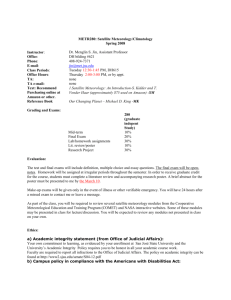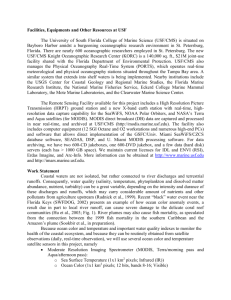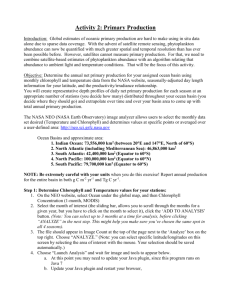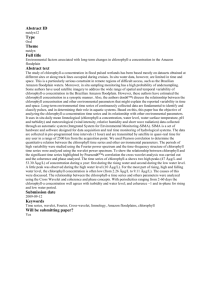Remote Detection of Eutrophic Events
advertisement
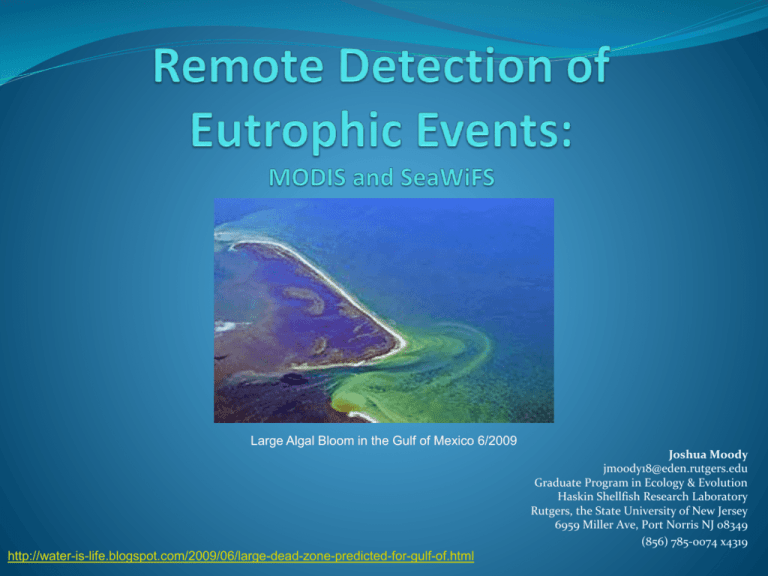
Large Algal Bloom in the Gulf of Mexico 6/2009 Joshua Moody jmoody18@eden.rutgers.edu Graduate Program in Ecology & Evolution Haskin Shellfish Research Laboratory Rutgers, the State University of New Jersey 6959 Miller Ave, Port Norris NJ 08349 (856) 785-0074 x4319 http://water-is-life.blogspot.com/2009/06/large-dead-zone-predicted-for-gulf-of.html What is Eutrophication • Process whereby water bodies receive excess nutrients that stimulate excessive plant growth (algae, periphyton attached algae, and nuisance plants weeds). • Nutrients can come from many sources • Fertilizers • Nitrogen from the atmosphere • Erosion of soils containing nutrients • Sewage treatment plant discharges. • Why we care: Subsequent decomposition of plant material reduces dissolved oxygen in the water Source: USGS, http://toxics.usgs.gov/definitions/eutrophication.html Extent of Continuous Eutrophic Conditions US Estuaries High expressions of eutrophic conditions (US): 44 estuaries 40% of the national estuarine surface area: Moderate expressions of eutrophic conditions (US) 40 estuaries When considered together: 65% of the nation's estuarine surface area (NOAA: get full citation from laptop) Indicators of Eutrophic Conditions Primary: elevated levels of chlorophyll a Secondary: depleted dissolved oxygen MODIS Chlorophyll image from Indian Subcontinent http://visibleearth.nasa.gov/view_rec.php?id=64 Detection of Chlorophyl a Visual: Algal blooms Green water May be hard to detect visually Chemical: In situ N and P levels Remote: Reflectance: 500-600nm and 700nm-3.5um Absorption: 400-500nm and 600-700nm The absorption maxima of chlorophyll a are lambda= 430 and lambda= 662 nm, that of chlorophyll b are at 453 and 642 nm. http://www.biologie.uni-hamburg.de/b-online/e24/3.htm Sensors MODIS: MODerate- resolution Imaging Spectroradiometer SeaWiFS: Sea-viewing Wide Field-of-view Sensor MODIS Aboard Terra and Aqua Satellites Viewing the entire Earth's surface every 1 to 2 days 36 spectral bands Orbit: 705 km, 10:30 a.m. descending node (Terra) or 1:30 p.m. ascending node (Aqua), sun-synchronous, nearpolar, circular Swath: 2330 km (cross track) by 10 km (along track at nadir) Bands 1 (620nm – 670nm), 3 (459nm – 479nm) & 4 (545nm – 565nm) commonly used Bands 8 (405nm-420nm) to 16 (862nm – 877nm) primary use is for Ocean Color/Phytoplankton/ Biogeochemistry http://earthobservatory.nasa.gov/Library/ESE/ese_2.html Spatial Resolution: 250 m (bands 1-2) 500 m (bands 3-7) 1000 m (bands 8-36) http://modis.gsfc.nasa.gov/index.php http://www.nasa.gov/centers/goddard/news/topstory/2003/0122japansnow.htm l MODIS Two-Wavelength Empirical Algorithm (De Cauwer et al., 2004) Aqua/MODIS - Phytoplankton Bloom in the Black Sea; Bands 1,4,3; June 27, 2006 http://visibleearth.nasa.gov/view_rec.php?id=20903 SeaWiFS Aboard GeoEye's OrbView-2 (SeaStar) satellite, an industry/government partnership with NASA's Ocean Biology Processing Group at Goddard Space Flight Center Utilizes 8 spectral bands with narrow wavelength ranges from 402nm to 885nm Orbit: 705 km circular sun-synchronous Orbital Period: 99 minutes Swath: Between 1,502km & 2,800km depending on datafile storage (LAC/GAC) Spatial Resolution: 1.1Km LAC; 4.5 Km GAC Specifically designed to monitor ocean characteristics such as chlorophyll-a concentration and water clarity Band 1 centered at 412nm specifically to identify yellow substances through increased blue wavelength adsorption Band 3 centered at 490nm to increase sensitivity to chlorophyll concentrations Band 7 (765nm) and Band 8 (865nm) in NIR are to specifically remove atmospheric attenuationaerosols adsorb linearly in NIR Able to tilt up to 20 degrees to avoid sunlight from the sea surface- important at equatorial latitudes where glint from sunlight often obscures water color http://www.orbital.com/SatellitesSpace/ImagingDefense/OV2/index.shtml http://oceancolor.gsfc.nasa.gov/SeaWiFS/ http://deepseanews.com/2007/09/ SeaWiFS Ocean Chlorophyll 4 Maximum Band Ratio Algorithm (De Cauwer et al., 2004) SEaWiFS natural color and a chlorophyll a map of the southern Atlantic Ocean of the Brazilian and Uruguayan coasts; 12-06-04 http://www.fas.org/irp/imint/docs/rst/Sect14/Sect14_13.html How are the Events Detected? Bio-optical reflectance and adsorption properties of organisms containing chlorophyll are known Surface, and just below surface, concentrations of chlorophyll a are determined by the radiance received by the sensor But satellite detection of chlorophyll concentrations suffer from uncertainties in the atmospheric correction and interference of other colored compounds. (Hu, 2005) Atmospheric Correction Retrieve water-leaving radiance Calculate atmospheric effects at 750nm and 865 nm (NIR) where water-leaving radiance is minimal. Extrapolate to visible wavelengths where chlorophyll a absorption is taking place Input desired wavebands, extraterrestrial irradiance, wind speed, Rayleigh scatter, and aerosol/ozone concentration. Output is normalized water leaving radiances at the 415-681 nm ocean wavebands http://oceancolor.gsfc.nasa.gov/VALIDATION/atm.html Problem: Detecting Algal Blooms in Coastal Waters Coastal waters can be the hosts of algal blooms- including harmful varieties (HABs) The color of the ocean, i.e., the spectral water-leaving radiance, is the combined result of the properties of various colored constituents in the surface ocean: Water molecules Phytoplankton Detritus Colored dissolved organic matter Suspended sediments Bottom reflectance These factors become a greater issue in shallow water where they can accumulate near the surface. (Hu, 2005) Problem Coastal areas have specific regional bio-optic properties Algorithms (MODIS, MERIS and SeaWiFS) designed for use at a global scaleparticularly for open ocean waters Higher amounts of suspended matter and yellow substances can make it impossible to detect the contribution of chlorophyll a absorption in the blue range (De Cauwer et al., 2004) Remote sensing’s contribution to evaluating eutrophication in marine and coastal waters: Evaluation of SeaWIFS data from 1997 to 1999 in the Skagerrak, Kattegat and North Sea (Sorensen et al., 2002) Chlorophyll-a maps obtained from SeaWiFS satellite images overestimate in situ observations of chlorophyll-a. The use of a ’rescaling’ function for chlorophyll-a values, defined with in situ data taken at the same time as the satellite images, has significantly decreased the uncertainties in the chlorophyll-a maps, even though some coastal areas still highlight chlorophyll-a overestimates. Red tide detection and tracing using MODIS fluorescence data: A regional example in SW Florida coastal waters (Hu et al., 2005) MODIS sensors are equipped with several bands specifically designed to measure the fluorescence of phytoplankton MODIS Chl a was estimated using a band-ratio algorithm (of all bands used to determine Ocean color) MODIS FLH (Fluorescence Line Height) was estimated using a baseline subtraction algorithm of Bands 13 (667nm), 14 (678nm) and 15 (748nm) (A baseline is first formed between radiances for Bands 13 and 15, and then subtracted from Band 14 radiance to obtain the FLH. MODIS FLH data showed the highest correlation with near-concurrent in situ chlorophyll-a concentration MODIS medium resolution bands and Turbidity Index Left Column: MODIS bands 1, 4, and 3 can clearly identify the distribution of the algal bloom Right Column: turbidity index, a semi-quantitative measure of the amount of particulate material in the near-surface water. Darker areas show higher turbidity While turbidity is not specific to algal blooms, it can be an estimate of the intensity of the bloom http://spg.ucsd.edu/Satellite_Projects/Various_HABs/Satellite_detection_of_HABs.htm (Kahru et al., 2004) The Future Higher resolution needed (as always)- for small scale blooms Greater differentiation between algae and yellow particulate material- refined algorithms Literature Cited http://toxics.usgs.gov/definitions/eutrophication.html http://modis.gsfc.nasa.gov/index.php http://envisat.esa.int/instruments/meris/ http://oceancolor.gsfc.nasa.gov/VALIDATION/atm.html http://oceancolor.gsfc.nasa.gov/SeaWiFS/ http://spg.ucsd.edu/Satellite_Projects/Various_HABs/Satellite_detection_of_HABs.htm Carder, Kendall L. , F. Robert Chen, Zhongping Lee, Steve K. Hawes, and Jennifer P. Cannizzaro . 2003. MODIS Ocean Science Team Algorithm Theoretical Basis Document ATBD 19 Case 2 Chlorophyll a Version 7. College of Marine Science, University of South Florida. De Cauwer, Vera, Kevin Ruddick, YoungJe Park, Bouchra Nechad and Michael Kyramarios. 2004. Optical Remote Sensing in Support of Eutrophication Monitoring in the Southern North Sea. EARSeL eProceedings 3; 208-222. Hu, Chuanmin, Frank E. Muller-Karger, Charles (Judd) Taylor, Kendall L. Carder, Christopher Kelble, Elizabeth Johns and Cynthia A. Heil. 2005. Red tide detection and tracing using MODIS fluorescence data: A regional example in Southwest Florida coastal waters. Remote Sensing of Environment 97 (2005) 311 – 321. Kahru, M., B.G. Mitchell, A. Diaz, M. Miura. MODIS Detects a Devastating Algal Bloom in Paracas Bay, Peru. EOS, Trans. AGU, Vol. 85, N 45, p. 465-472, 2004. Sørensen, Kai , Gunnar Severinsen, Gunni Ærtebjerg, Vittorio Barale, Christian Schiller, and Anita Künitzer. 2002. Remote sensing’s contribution to evaluating eutrophication in marine and coastal waters: Evaluation of SeaWIFS data from 1997 to 1999 in the Skagerrak, Kattegat and North Sea . European Environment Agency. Copenhagen, Denmark.

